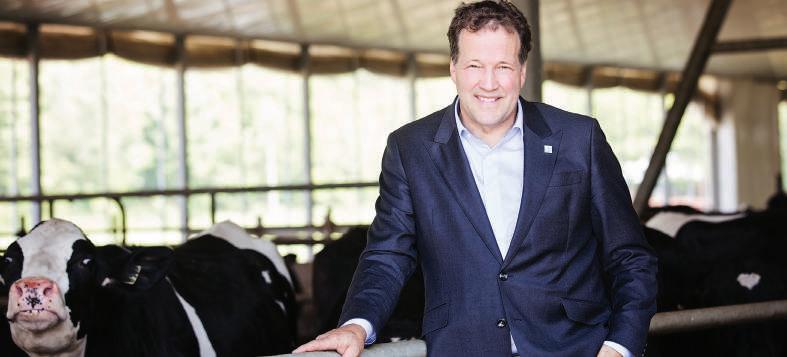
8 minute read
A YEAR TO REMEMBER
from January 2021
by MilkProducer
Reflecting on the impact of COVID-19 on Canada’s dairy industry— from farm to processing to export—and what’s ahead

J.P. GERVAIS, LEAD ECONOMIST AT FARM CREDIT CANADA
—J. P. Gervais
By Treena Hein CONTRIBUTOR
At the start of the pandemic, no one in Canada’s dairy sector could tell how 2020 would play out. However, at this point, J.P. Gervais, lead economist at Farm Credit Canada, says while Canada’s dairy sector had a challenging time adjusting in the first stage of the crisis, demand for dairy products was overall higher than normal last year. He says strong demand was apparent not long after the pandemic was declared and did not change as 2020 progressed.
“As people were confined to their homes in March and fear about food availability led to some hoarding, there was a major overall increase in dairy consumption,” Gervais notes. “Shipments were up 33 per cent that month compared with 2019. April was also like 2019. But at the same time, demand for products used in food service and high-end restaurants, such as cream, dropped substantially. We don’t have precise numbers relating to dairy consumption from food service, but we know demand dropped.”
At the processing level in 2020, Gervais has data going as far as September showing an overall rise of 16 per cent in dairy product sales, especially in butter and cheese. This was due to the large number of people cooking and baking at home, as well as having their coffee and tea at home, where many people were also working. Specifically about butter, while Gervais notes the national inventory of this product is always fluctuating, butter stocks were declining heading into December 2020, likely due to more home baking across the nation.
Gervais says it’s always good news for dairy farmers when butter and cheese is consumed at higher rates because of the fat content—fat is worth the most to producers. But the market for solids non-fat remains a challenge—extra challenging this year compared with the significant challenge to sell this product over the last four to five years.
“I think another factor in the overall use of dairy products, especially cheese and yogurt, is the price of dairy protein remained affordable— it did not increase as much—compared with the prices of other proteins, such as pork and beef in the summer,” Gervais says. “Even the price of eggs increased more than dairy products.”
PROCESSING CHANGES
To understand more about how demand for dairy products has shifted this year, Mathieu Frigon, president and chief executive officer of Dairy Processors Association of Canada (DPAC), provides insight.
With the closure of food service and hotels in the early days of the pandemic, cream was the dairy product that was hardest hit, he says. Using data from Statistics Canada and Global Affairs Canada, DPAC calculates the domestic disappearance of dairy products. Before COVID-19, demand for cream had grown by four per cent on an annual basis, and in September 2020, it declined at a rate of 2.7 per cent. Demand for butter was also growing before the pandemic hit and it’s still growing, Frigon reports. Demand for yogurt was declining slightly before COVID-19 and is still declining, but to a lesser extent.
“Fluid milk consumption had been declining slightly for years and it’s now growing slightly with everyone being at home, cooking and baking,” he notes. “Demand for cheese is growing at almost five per cent as of the end of 2020. That number includes imports. The Canada-United States-Mexico Agreement (CUSMA) entered into force in July 2020, which allowed more imports of cheese and other dairy products. So, for Canadian-made cheese, consumption is now growing at about three per cent.”
Frigon believes the most important realization for the dairy industry from the pandemic is Canada must ensure it has a resilient food system. He says this summer, many retailers applied arbitrary fees on dairy processors and other product suppliers, an issue that has been going on for years.
“Here in Canada, these fees came to a boiling point this year when COVID-19 put the supply chain under tremendous stress,” he says. “The fees were particularly hard on processors that had been producing products that mostly went to food service and hotels. That type of approach will make our food system weaker and that’s why we’ve been calling for a Grocery Code of Conduct.”
“These codes have been implemented in the United Kingdom, Australia, Ireland and Norway, and everyone involved in these countries are pleased,” he says. “It brings everyone in the supply chain together and instead of fighting over fees, the focus is on stability and having everyone benefit. We now have a joint working group with the federal and provincial governments to look at this important issue, and we’re very happy about that. We are hopeful a grocery code could be proposed in 2021.”

MATHIEU FRIGON, PRESIDENT OF DAIRY PROCESSORS ASSOCIATION OF CANADA

DAVID WIENS, VICE-PRESIDENT OF DAIRY FARMERS OF CANADA
ON THE FARM
At least one of these challenges—namely, a changing supply chain—presented itself to dairy farmers in Canada at the onset of the pandemic, but the supply management system allowed the industry to adapt quickly. While the uncertainty and adaptation have been stressful on farmers, David Wiens says at this point, the pandemic has also provided some significant silver linings. Wiens is vice-president of Dairy Farmers of Canada and chair of Dairy Farmers of Manitoba, and he has a dairy farm south of Winnipeg, Man.
The start of the pandemic was a time of great uncertainty, and for dairy farmers, when restaurants and hotels closed, there was an initial spike in fluid milk demand.
“It looked like we would have to ramp up production quickly but then demand fell away,” Wiens explains. “Farmers had to reduce production, and by early summer, the market started to stabilize and the supply chain issues were sorted out.”
Although, as Gervais pointed out, demand for dairy products became strong quite quickly as most Canadians stayed home, cooked and baked. Wiens notes starting in early March, some of this demand was filled by imports of dairy products, which later increased when CUSMA came into effect.
Leaders in the P5 and Western Milk Pool took slightly different steps to reduce production, and in December, began to take similar steps to ramp up production.
“We didn’t have a playbook to go to, and we managed our response as best we could with the information we had,” Wiens says. “The eastern and western pools worked very closely and communicated with farmers across Canada about quota, and that’s a positive. Also, the communication between the provincial associations really developed.”
The evolution of communicating virtually with producers within each province has also been a positive—one that Wiens thinks will stay in place to some extent going forward.
“We’ve tried different online platforms, and in Manitoba and other provinces, we’ve had a number of farmer discussions with 80 to 100 farmers about how things were being managed—it’s working very well,” Wiens says.
This system of meetings, where farmers can take an hour or two from their day and attend a meeting online instead of having to take a day or two to drive to a meeting, is very convenient. Wiens says there’s been a lot of positive feedback in Manitoba.
“With online meetings, no one is disadvantaged in terms of access,” he explains. “Also, I think it makes it more equal in terms of participation. Everyone can attend and I think it’s resulted in a better feel across the country for what is going on in the industry. Those who are timid about speaking up in a conventional meeting can type their question. So, I think online meetings will stay, and will be a lasting positive legacy of all this.”
On the topic of communication, to help dairy farmers in Europe deal with future threats, a new project called Smart-ET has been undertaken, funded by EIT Food and in collaboration with several universities. The goal of the project is to develop digital tools that will enable farmers and dairy retailers to quickly adapt to rapid market changes in case of extreme events which disrupt normal ways of working. For example, within the envisioned centrally-available communication system, retailers can issue inventory alerts that will help reduce the potential for the disposal of otherwise marketable dairy products.
2021 AND BEYOND
Besides better communication within the dairy farming community, Gervais identifies another silver lining for farmers due to this crisis. Because demand for Canadian dairy products grew from 2014 to 2018, some producers have been expanding.
Looking forward, Gervais expects the Canadian dairy industry to have a less volatile year in 2021 compared with 2020, but the pandemic will continue to have an effect on it, as will the new trade deals.
“Many people have savings from not being able to spend as freely, so there will be some pent-up spending, but how will this affect dairy?” he asks. “Food service will open again, and there will be lots of various celebrations. We know a share of workers will be going back to the office, so coffee service will come back. There will be shifts in product demand, but they won’t be as fast as they were in 2020, and the industry will also have that experience of planning under uncertain conditions.”
COMPARING CANADA
Dr. Torsten Hemme, managing director of the IFCN Dairy Research Centre, noted at the 21st International Farm Comparison Network Dairy Conference held online in June 2020, the two countries that could be considered as the “epicentre of the dairy crisis” at that point were the United States and India, with large drops in milk price occurring.
Compared with Canada, the situation was more dire for U.S. dairy processors. Many of them shut down due to the closing of schools, restaurants and hotels, notes
a group of scientists from the U.S. and China who recently published a study on the effect of the pandemic on the dairy industries in those two countries. In China, processors where affected by widespread road closures and a significant reduction in dairy products that are popular on Chinese holidays. Overall, the two countries’ industries were both affected by decreased farmgate milk prices, supply chain disruption, worker shortages, increased production costs and a lack of operating capital.




